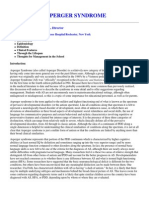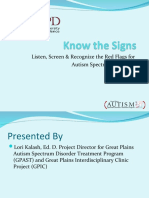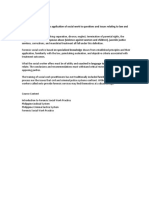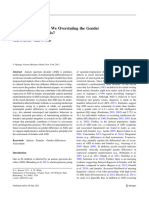What Are The Signs of Autism in Girls
What Are The Signs of Autism in Girls
Uploaded by
Ana Sofia Nunes JorgeCopyright:
Available Formats
What Are The Signs of Autism in Girls
What Are The Signs of Autism in Girls
Uploaded by
Ana Sofia Nunes JorgeOriginal Title
Copyright
Available Formats
Share this document
Did you find this document useful?
Is this content inappropriate?
Copyright:
Available Formats
What Are The Signs of Autism in Girls
What Are The Signs of Autism in Girls
Uploaded by
Ana Sofia Nunes JorgeCopyright:
Available Formats
What Are the Signs of Autism
in Girls – Is Asperger’s in Girls
Overlooked?
What Are the Signs of Autism in Girls – Is Asperger’s in Girls Overlooked?
Girls with autism have long been misdiagnosed as their symptoms look quite different from those of their
male peers on the spectrum. New research indicates that autism in girls is more common than previously
thought as more is learned about the signs of autism in girls.
Are there fewer girls with autism or are they
not being diagnosed?
What Are the Signs of Autism in Girls
What Are the Signs of Autism in Girls – Is Asperger’s in Girls Overlooked?
When most people think of autism spectrum disorder (ASD) or high functioning autism, often called
Asperger’s syndrome, boys and men often come to mind. An obsessive desire to memorize facts and
collect information on a subject they are especially interested in or the inability to have typical social
interactions and maintain friendships, or even exceptional intelligence (often confused with savant
syndrome) are often considered hallmarks of ASD and Asperger’s syndrome.
Autism has previously been estimated to affect 1 in 68 children in the United States and has been thought
to be four times as prevalent in boys than in girls. Girls with autism were considered to be more seriously
affected and often also diagnosed with intellectual disabilities. Research now suggests that both these
ideas are wrong. (Szalavitz, 2016)
A study published in the Journal of Autism and Developmental Disorders describes two trains of thought as
to why girls and boys with autism present differently. The first theory is that “being female confers
protection against autism traits because of sex differences in neuroendocrine function,” due to higher levels
of oxytocin, which “encourage nurturance and affiliation and provide protection in girls against the
development of autistic traits.” (Solomon, Miller, Taylor, Hinshaw, & Carter, 2011)
The second theory by Simon Baron-Cohen is that “high levels of fetal testosterone may predispose boys to
have ‘extreme male brains,’ characterized by phenotypes involving elevated ‘systematizing’ (focus on
inanimate systems and details) versus ‘empathizing’ (focus on interpersonal orientation). A diagnosis may be
missed because girls often portray milder symptoms than their male peers and “referral biases given that
they are still more socially adept than boys with and without ASD based on their relative strengths in social
skills are caretaking.” (Solomon, Miller, Taylor, Hinshaw, & Carter, 2011)
Signs of autism in girls and how they differ
from boys with ASD
Asperger’s in girls presents differently than in their male counterparts. While boys with an ASD may collect
information about topics that hold special meaning to them, girls with Asperger’s tend to align interests with
those of their neurotypical peers, but in a “more focused way.” A teenage girl may collect makeup and
study its application as done by a favorite makeup artist while a younger girl may learn the history of Barbie
dolls or study her American Girl books. (Steward, 2014)
This may make the condition harder to recognize and may only become noticeable around puberty when
social interactions become more complex, and the pressure to conform is overwhelming.
Young girls with autism might perform at an average to excellent level at school, even socializing at what
appears to be an age-appropriate level. “Some girls with Asperger’s will manage to keep their difficulties
under wraps at school, but might have ‘meltdowns’ at home, where they feel safe to relax and release the
feelings that they have been squashing down all day.” (Steward, 2014)
Robyn Steward compiled the following list for the BBC of typical difficulties that may be faced by someone
with Asperger’s syndrome:
What Are the Signs of Autism in Girls
What Are the Signs of Autism in Girls – Is Asperger’s in Girls Overlooked?
nderstanding non-verbal communication, such as body language or tone
U
Interpreting the feelings, thoughts or motives of others
Relating to non-literal uses of language, such as idioms, jokes or irony
Following social conventions such as respecting another person’s physical space
Depending on familiar routines and feeling anxious if these are not adhered to
Experiencing sensory dif culties, for example being overpowered by visual, auditory or tactile stimuli
Limits to body awareness, for example, walking around obstacles or carrying out ne motor tasks. (Steward,
2014)
Are women and girls with autism being
misdiagnosed?
Boys and girls develop differently particularly throughout puberty. Girls are traditionally thought to mature
faster, develop social skills and emotional intelligence sooner, and have a greater awareness of the world
around them. These differences are often noticeable between neurotypical boys and girls as well as boys
with autism and their neurotypical peers of both genders. However, girls with autism frequently present to
be less socially adept than their neurotypical female peers, but do not seem to struggle as much as boys of
the same age with autism. According to Maia Szalavitz, “females with autism may be closer to typically
developing males in their social abilities than typical girl or boys with autism.” (Szalavitz, 2016)
This gray area has left many women and girls with autism without a diagnosis that could, in turn, help them
gain access to therapies that could help them.
A 2014 study by psychologist Thomas Frazier of the Cleveland Clinic found that girl who had been
diagnosed with autism had lower IQs than their neurotypical peers as well as extreme behavior problems.
The girls were also less likely to present with signs of restricted interests (usually a diagnostic factor for
Asperger’s syndrome).
Current diagnostic tests typically focus on “male” interests and are not inclusive of restrictive interests with
which a young girl or woman may present. Kevin Pelphrey, a researcher at Yale University’s Child Study
Center, and father of two with autism, told Szalavitz that current diagnostic tests are derived from studies
(almost exclusively) of boys and that he believes this may be why so many girl and women are under
diagnosed/misdiagnosed. (Szalavitz, 2016)
What Are the Signs of Autism in Girls
What Are the Signs of Autism in Girls – Is Asperger’s in Girls Overlooked?
Don't miss out on our special offer. Click here to find out more
Common co-occurring disorders associated
with Asperger’s Syndrome in girls
Women and girls with Asperger’s syndrome often find themselves misdiagnosed or at a higher risk for co-
occurring conditions which may be derived as coping skills or entirely separate issues. According to a study
published online on the US National Library of Medicine National Institute of Health website, women and
girls with Asperger’s syndrome are likely to have higher instances of depression, bipolar disorder, anxiety,
obsessive-compulsive disorder, and attention deficit hyperactivity disorder (ADHD). While these issues may
be co-occurring, they are often diagnosed as the only explanation for the symptoms presented by a girl
with Asperger’s syndrome. Seeing the larger picture of how and ASD fits in with a co-occurring disorder is
crucial to providing the girl or woman with the best therapies and resources available.
Anxiety-based disorders such as generalized anxiety, social anxiety, and obsessive-compulsive disorder
have been reported in greater instances in girls with Asperger’s syndrome than their otherwise neurotypical
peers. According to the study mentioned above, 56% of people with Asperger’s syndrome meet the criteria
of a diagnosis of anxiety with 22% diagnosed with social anxiety disorder, 22% diagnosed with generalized
anxiety disorder, 13% diagnosed with panic disorder, 15% diagnosed with agoraphobia, and 7% diagnosed
with obsessive-compulsive disorder. (Mazzone, Ruta, & Reale, 2012)
Researchers are also finding that women and girls with autism have “striking similarities in the cognitive
profiles” to women with anorexia nervosa, according to psychiatrist Janet Treasure of King’s College London.
Treasure says that “both people with autism and those with anorexia tend to be rigid, detail-oriented and
distressed by change[s].” A diagnosis of anorexia nervosa may explain away symptoms and therefore
prevent girls from being diagnosed as having an ASD. Treasure stressed that the majority of women with
anorexia nervosa do not have autism, but that women with anorexia have higher levels of autistic traits than
typical women. (Szalavitz, 2016)
What Are the Signs of Autism in Girls
What Are the Signs of Autism in Girls – Is Asperger’s in Girls Overlooked?
Some women with autism who receive a diagnosis of anorexia nervosa may be eating extremely restricted
diets due to sensory issues surrounding food texture and other preferences, while other’s eating disorders
may be triggered by the more typical stressors and pressure associated with anorexia nervosa. An
estimated 23% of women diagnosed with anorexia nervosa also have an ASD. (Szalavitz, 2016)
ADHD may be the most common diagnosis girls receive before, or in some cases instead of, Asperger’s
syndrome. The overlap of symptoms can make it difficult to diagnose girls and women on the spectrum,
especially with current diagnostic models largely representing the male presentation of autism. Many girls
with autism retain their diagnosis of ADHD, but in conjunction with an ASD diagnosis have a greater
explanation for their experiences and access to more resources to help them.
Acknowledging this fuller picture is crucial to helping not only girls with Asperger’s syndrome, but their
families make sense of the world through the unique lens of autism.
How can a diagnosis help a girl with autism?
Just as with their male counterparts, women and girls with autism benefit greatly from being diagnosed at a
young age. An early diagnosis can mean earlier access to therapies and resources and more time for the
girl and her family to learn how to cope with an ASD diagnosis. Early intervention is key, but a diagnosis later
in life is better than no diagnosis at all. Young and adult women who are diagnosed with autism might have
to play catch-up on social skills and coping mechanisms, but after an adjustment period, most girls and
woman find relief from receiving their diagnosis. After a diagnosis is given, you or your child can be placed
with therapists, occupational therapists, psychiatrists, or other professionals who can answer questions and
help you or your child to live a fuller life.
Social skills classes are available to help women and girls with autism learn how to cope with challenging
social situations and form interpersonal relationships. Therapists can also help girls manage co-occurring
conditions such as anxiety, depression, bipolar disorder, obsessive-compulsive disorder (OCD), or anorexia
form positive coping skills and make sense of these other disorders as they pertain to a girl or woman on
the autism spectrum.
What is the cost of not knowing?
Seeking testing for ASD, especially for a girl, can be a daunting undertaking. As a parent, you might feel
conflicted as to whether a diagnosis is necessary for your daughter. It is important to keep in mind that
people with autism can live fulfilling and beautiful lives. A diagnosis will open the door to further therapies
and resources for you and your child.
Even if your daughter is already well into adolescence, the skills that a trained specialist can help her
develop are invaluable. Girls with autism who struggle with setting social boundaries or find challenges in
maintaining meaningful relationships are at a higher risk for sexual exploitation and staying in abusive
relationships. A study by Baron-Cohen found that “66% of adults with the milder form of ASD (Asperger’s)
reported suicidal thoughts, at a rate nearly 10 times higher than seen in the general population. The
proportion was 71% among women, who made up the sample.” (Szalavitz, 2016)
What Are the Signs of Autism in Girls
What Are the Signs of Autism in Girls – Is Asperger’s in Girls Overlooked?
Girls with autism are also at a higher risk for affective (mood) disorders such as depression, anxiety, and
bipolar disorder. (Solomon, Miller, Taylor, Hinshaw, & Carter, 2011)
Finding a specialist who understands autism in girls and women is crucial to helping your daughter learn
how to set boundaries, speak her truth, and manage her mental health.
What kinds of therapies can benefit girls with
autism?
Girls with autism have a variety of options for therapies. Applied Behavioral Analysis (ABA) is particularly
helpful for young girls (under the age of five), but older girls can benefit as well. ABA helps to manage
challenging behaviors through positive reinforcement, as well as teach social and motor skills. Adolescent
girls may benefit greatly from psychotherapy or “talk therapy” with a psychologist who is trained to help
girls with autism.
During psychotherapy, the client and therapist will work together to process challenging situations and
create plans with manageable steps to address unhealthy thought processes of behaviors. A
psychotherapy session is a place where clients are encouraged to ask questions, vent, and seek guidance.
Occupational therapy is another option for children who need help establishing routines and carrying out
daily tasks. An occupational therapist can help your daughter learn skills that will help her at home, school,
or in the workplace.
Girls and women with co-occurring disorders such as obsessive-compulsive disorder, anorexia nervosa, or
who are trauma survivors may need additional specialists on their team. As more women and girls are
receiving ASD diagnosis, specialists are becoming more aware of the unique way women and girls on the
autism spectrum present and are developing new ways to help them thrive. If you are unsure where to
begin, your daughter’s pediatrician or primary care doctor will likely be able to connect you with resources
in your area.
References:
Bargiela, S., Steward, R., & Mandy, W. (2016, July 25). The Experiences of Late-diagnosed Women with
Autism Spectrum Conditions: An Investigation of the Female Autism Phenotype. Retrieved from
https://link.springer.com/article/10.1007/s10803-016-2872-8
(Bargiela, Steward, & Mandy, 2016)
Mazzone, L., Ruta, L., & Reale, L. (2012, June 25). Psychiatric comorbidities in Asperger syndrome and high
functioning autism: Diagnostic challenges. Retrieved from
https://www.ncbi.nlm.nih.gov/pmc/articles/PMC3416662/
(Mazzone, Ruta, & Reale, 2012)
What Are the Signs of Autism in Girls
What Are the Signs of Autism in Girls – Is Asperger’s in Girls Overlooked?
Solomon, M., Miller, M., Taylor, S. L., Hinshaw, S. P., & Carter, C. S. (2011, March 26). Autism Symptoms and
Internalizing Psychopathology in Girls and Boys with Autism Spectrum Disorders. Retrieved from
https://link.springer.com/article/10.1007/s10803-011-1215-z
(Solomon, Miller, Taylor, Hinshaw, & Carter, 2011)
Steward, R. (2014, August 16). Lesser-known things about Asperger’s syndrome. Retrieved from
https://www.bbc.com/news/blogs-ouch-28746359
(Steward, 2014)
Szalavitz, M. (2016, March 01). Autism–It’s Different in Girls. Retrieved from
https://www.scientificamerican.com/article/autism-it-s-different-in-girls/
(Szalavitz, 2016)
What Are the Signs of Autism in Girls
You might also like
- MIGDAS TemplateDocument2 pagesMIGDAS TemplatedannibreeccNo ratings yet
- A New Understanding of ADHD in Children and Adults Executive Function Impairments (PDFDrive)Document230 pagesA New Understanding of ADHD in Children and Adults Executive Function Impairments (PDFDrive)Willian vieira Pereira100% (7)
- Case Report SampleDocument32 pagesCase Report Samplekhadija100% (2)
- PARDI AR Q V1.1 Instructions For Administrators SLaMDocument2 pagesPARDI AR Q V1.1 Instructions For Administrators SLaMMarlon Chacon CamachoNo ratings yet
- Gilliam Autism Rating Scale - Third Edition (GARS-3) : Pro-Ed USADocument1 pageGilliam Autism Rating Scale - Third Edition (GARS-3) : Pro-Ed USAloki1138No ratings yet
- The Childhood Autism Spectrum Test (CAST) : Yes No Yes No Yes No Yes No Yes NoDocument4 pagesThe Childhood Autism Spectrum Test (CAST) : Yes No Yes No Yes No Yes No Yes NoZainub A Khan100% (1)
- Aspergers Syndrome Through The LifespanDocument8 pagesAspergers Syndrome Through The Lifespanadrian zach benjaminNo ratings yet
- Asd WheelDocument1 pageAsd Wheelapi-306652917No ratings yet
- JoDD 17-1 26-37 Schroeder Et AlDocument12 pagesJoDD 17-1 26-37 Schroeder Et AlEspíritu Ciudadano100% (1)
- M Chat Tamil 2020Document8 pagesM Chat Tamil 2020Profe CatalinaNo ratings yet
- File 1663148139 0005620 AUTISMDocument45 pagesFile 1663148139 0005620 AUTISM2022824838.pasangNo ratings yet
- Assessment For AutismDocument104 pagesAssessment For AutismP Olarte ESNo ratings yet
- Autism and EmpathyDocument6 pagesAutism and EmpathyMichael SmithNo ratings yet
- A Look Into Autism, and The Self Admiration: Puzzle Ofthe DisordersDocument13 pagesA Look Into Autism, and The Self Admiration: Puzzle Ofthe DisordersJessica Cisneros100% (1)
- Ados-2 2014Document5 pagesAdos-2 2014Mariana Pestana0% (1)
- NIH Public AccessDocument23 pagesNIH Public AccessBárbara AndreaNo ratings yet
- Assessment of ASDs - Psychopharm Update PDFDocument55 pagesAssessment of ASDs - Psychopharm Update PDFMihai PredescuNo ratings yet
- Autism Assessment in The SchoolsDocument38 pagesAutism Assessment in The SchoolsbrainworkswpgNo ratings yet
- Autistic Burnout Vs Depression - Insights of A Neurodivergent ClinicianDocument4 pagesAutistic Burnout Vs Depression - Insights of A Neurodivergent ClinicianAna Júlia AraújoNo ratings yet
- Mental Health & Wellbeing For Children & Young People - Part TwoDocument24 pagesMental Health & Wellbeing For Children & Young People - Part Twomariya khanNo ratings yet
- Autism: Autism Diagnosis DSM IV MatchDocument6 pagesAutism: Autism Diagnosis DSM IV MatchReyhan VivaldyNo ratings yet
- Autism ENGDocument1 pageAutism ENGWillem HeesbeenNo ratings yet
- Childhood Autism Rating Scale, 2nd EditionDocument25 pagesChildhood Autism Rating Scale, 2nd Editionarunimajha127No ratings yet
- Use of The ADOS and ADI-R in Children With PsychosisDocument25 pagesUse of The ADOS and ADI-R in Children With PsychosiscaristaNo ratings yet
- Adaptive Behavior Profiles in Autism Spectrum Disorders: DisclosuresDocument14 pagesAdaptive Behavior Profiles in Autism Spectrum Disorders: DisclosuresAbd El-RahmanNo ratings yet
- Autism PDFDocument41 pagesAutism PDFflower21No ratings yet
- Listen, Screen & Recognize The Red Flags For Autism Spectrum DisordersDocument28 pagesListen, Screen & Recognize The Red Flags For Autism Spectrum DisordersThe Autism NOW CenterNo ratings yet
- Utism Hysician Andbook: Canadian EditionDocument42 pagesUtism Hysician Andbook: Canadian EditionAngela Cameron100% (1)
- The Impacts of Autism On The FamilyDocument4 pagesThe Impacts of Autism On The FamilyRuth Arcibal RomeroNo ratings yet
- Vineland-Ii Presentation - Monique and Pat - Final VersionDocument22 pagesVineland-Ii Presentation - Monique and Pat - Final Versionapi-163017967No ratings yet
- WWW - Pica.gov - JM Wp-Content Uploads 2014 06 Jamaica-Passport-Application-Compressed PDFDocument6 pagesWWW - Pica.gov - JM Wp-Content Uploads 2014 06 Jamaica-Passport-Application-Compressed PDFlorna_thomas3348No ratings yet
- Makingan Autism Spectrum Disorder DiagnosisDocument36 pagesMakingan Autism Spectrum Disorder DiagnosisGeruza OliveiraNo ratings yet
- AUTISM 101: A Psychoeducational Intervention For Parents of Newly Diagnosed Children With Autism Spectrum DisorderDocument1 pageAUTISM 101: A Psychoeducational Intervention For Parents of Newly Diagnosed Children With Autism Spectrum DisorderAUCDNo ratings yet
- BBBB, Aaaa Deidentified No ASDDocument16 pagesBBBB, Aaaa Deidentified No ASDRomina Gisell Trogo100% (1)
- Autism Spectrum DisorderDocument33 pagesAutism Spectrum Disorderfcb rmaNo ratings yet
- Vineland AutismDocument17 pagesVineland AutismfabcardososNo ratings yet
- NAIT Guide To Using ADOS With Adults FAQs 2022Document9 pagesNAIT Guide To Using ADOS With Adults FAQs 2022CJ SNo ratings yet
- SNAPDocument2 pagesSNAPEmily MuirNo ratings yet
- List PDFDocument68 pagesList PDFParul SehgalNo ratings yet
- Autism Spectrum DisorderDocument58 pagesAutism Spectrum DisorderPriscilla ChumrooNo ratings yet
- Ahdh DSM5Document53 pagesAhdh DSM5Sara Araujo100% (2)
- Specialist Assessment Service Referral Form September 2017Document14 pagesSpecialist Assessment Service Referral Form September 2017Rebecca CurranNo ratings yet
- Module 1 - Intro To Forensic Social WorkDocument1 pageModule 1 - Intro To Forensic Social WorkJefran OlingayNo ratings yet
- Neuropsychological Assessment in Children: Jornal de PediatriaDocument6 pagesNeuropsychological Assessment in Children: Jornal de PediatriaBenja MoranNo ratings yet
- DSM5-Reflexion in AutismDocument7 pagesDSM5-Reflexion in AutismBianca NuberNo ratings yet
- Coventry Model Development PaperDocument15 pagesCoventry Model Development PaperAliens-and-antsNo ratings yet
- Parental Stress in Parents of Special CHDocument7 pagesParental Stress in Parents of Special CHdianaNo ratings yet
- Evidence-Based Review of Interventions For Autism Used in or of Relevance To Occupational TherapyDocument14 pagesEvidence-Based Review of Interventions For Autism Used in or of Relevance To Occupational TherapyGabriela LalaNo ratings yet
- Leading The Way: Autism-Friendly Youth Organization GuideDocument67 pagesLeading The Way: Autism-Friendly Youth Organization Guiderusa rusaNo ratings yet
- Medical Report: Patient Name: Dob: ID: Clinic: Physician: Report DateDocument6 pagesMedical Report: Patient Name: Dob: ID: Clinic: Physician: Report DateSudhansh KumarNo ratings yet
- Three Categories of AutismDocument14 pagesThree Categories of Autismapi-327260204No ratings yet
- Communicationof AutismDocument4 pagesCommunicationof AutismDayna DamianiNo ratings yet
- Adolescent Girls With An Autism Spectrum Disorder1Document14 pagesAdolescent Girls With An Autism Spectrum Disorder1Queen DebbsNo ratings yet
- Psychology Project 2016-2017: The Indian Community School, KuwaitDocument21 pagesPsychology Project 2016-2017: The Indian Community School, KuwaitnadirkadhijaNo ratings yet
- C.2 Autism Spectrum 072012 PDFDocument27 pagesC.2 Autism Spectrum 072012 PDFGemma GarciaNo ratings yet
- Dads and AutismDocument50 pagesDads and AutismcirclestretchNo ratings yet
- Autism DyslexiaDocument2 pagesAutism DyslexiaAutismDyslexiaNo ratings yet
- Devereux Early Childhood Assessment For Infants AnDocument55 pagesDevereux Early Childhood Assessment For Infants AnAngana NandyNo ratings yet
- ASD in Females Are We Overstating The GenderDocument18 pagesASD in Females Are We Overstating The GendervcuadrosvNo ratings yet
- Adults With Autism Spectrum DisorderDocument9 pagesAdults With Autism Spectrum DisorderAnaLaura JulcahuancaNo ratings yet
- Tenderfeet Stitches - Sew Super Easy Summer Sun Hat!Document4 pagesTenderfeet Stitches - Sew Super Easy Summer Sun Hat!Ana Sofia Nunes JorgeNo ratings yet
- Vestido de Mangas Compridas Com Folhos para Bonecas de 46 CmsDocument4 pagesVestido de Mangas Compridas Com Folhos para Bonecas de 46 CmsAna Sofia Nunes JorgeNo ratings yet
- London Dress PDF Pattern Tutorial - LayeredDocument44 pagesLondon Dress PDF Pattern Tutorial - LayeredAna Sofia Nunes Jorge100% (1)
- Moldes VestidosDocument60 pagesMoldes VestidosAna Sofia Nunes Jorge100% (1)
- Access Foundation Programme 2023Document40 pagesAccess Foundation Programme 2023Maria Eduarda Souza NascimentoNo ratings yet
- 1.51.1 (PSYCH) Psychiatric Disorders and AddictionDocument3 pages1.51.1 (PSYCH) Psychiatric Disorders and AddictionAndriel Gayle P. YuloNo ratings yet
- Couvy Duchesne 2018Document12 pagesCouvy Duchesne 2018spaciugNo ratings yet
- MD Papers NewDocument27 pagesMD Papers NewVinay V KulkarniNo ratings yet
- Reviewer in Fsie MidtermDocument10 pagesReviewer in Fsie MidtermKyla CabullosNo ratings yet
- Common Medical AbbreviationDocument25 pagesCommon Medical AbbreviationKim Glaidyl BontuyanNo ratings yet
- Autism Perspective in IndiaDocument15 pagesAutism Perspective in Indiashruti kumarNo ratings yet
- San Francisco St. Butuan City 8600, Region XIII Caraga, PhilippinesDocument1 pageSan Francisco St. Butuan City 8600, Region XIII Caraga, PhilippinesTrisha Joy T. JumonongNo ratings yet
- Rimrodt, S. L., & Lipkin, P. H. (2011) Learning Disabilities and School Failure Pediatrics in ReviewDocument12 pagesRimrodt, S. L., & Lipkin, P. H. (2011) Learning Disabilities and School Failure Pediatrics in ReviewSdNNo ratings yet
- The Impact of Technology On The Developing Child, Their Experience and Capabilities. IntroductionDocument17 pagesThe Impact of Technology On The Developing Child, Their Experience and Capabilities. IntroductionleizelNo ratings yet
- Aggression in ChildrenDocument5 pagesAggression in ChildrenRizki TiyasNo ratings yet
- Methylphenidate for Attention Deficit Hyperactivity Disorder (ADHD) in Children and AdolescentsDocument546 pagesMethylphenidate for Attention Deficit Hyperactivity Disorder (ADHD) in Children and AdolescentsPiotr ChmolewskiNo ratings yet
- Medsurg AdhdDocument3 pagesMedsurg AdhdminniprkNo ratings yet
- AdhdDocument7 pagesAdhdAnca CzifraNo ratings yet
- Misdiagnosis and Dual Diagnoses of Gifted Children and Adults: Adhd, Bipolar, Ocd, Asperger's, Depression, and Other Disorders (2nd Edition)Document23 pagesMisdiagnosis and Dual Diagnoses of Gifted Children and Adults: Adhd, Bipolar, Ocd, Asperger's, Depression, and Other Disorders (2nd Edition)averilwinterbottomhi100% (14)
- Rhythms of Life - Circadian Disruption and Brain Disorders Across The LifespanDocument17 pagesRhythms of Life - Circadian Disruption and Brain Disorders Across The LifespanMakanudo.No ratings yet
- 1 07a-NeurodevDocument75 pages1 07a-NeurodevNirav CHOVATIYANo ratings yet
- Found 101 ReportDocument36 pagesFound 101 ReportjaymarroceroNo ratings yet
- C1. Proficiency Template From Anglia ExaminationsDocument12 pagesC1. Proficiency Template From Anglia ExaminationsMarcos ChiappiniNo ratings yet
- Mental Health Needs of Juvenile Offenders: Juvenile Justice Guide Book For LegislatorsDocument12 pagesMental Health Needs of Juvenile Offenders: Juvenile Justice Guide Book For LegislatorsNovelyn Calacala JacobNo ratings yet
- PSYCH2GO-HQ-Spread (Double Sided Cover) PDFDocument40 pagesPSYCH2GO-HQ-Spread (Double Sided Cover) PDFkichutesNo ratings yet
- Module 3 FSIE BTVTED III A and BDocument10 pagesModule 3 FSIE BTVTED III A and BJhonnas obstaculoNo ratings yet
- Group 2 - Psychology I: Group Members Sitjar Ajoc Celestial Espanto Teraytay 27 March/ 13 AprilDocument40 pagesGroup 2 - Psychology I: Group Members Sitjar Ajoc Celestial Espanto Teraytay 27 March/ 13 AprilMark Lean EspantoNo ratings yet
- Full Elc 25-5Document51 pagesFull Elc 25-5zone100% (2)
- DSM-5 2011 - BPS ResponseDocument26 pagesDSM-5 2011 - BPS ResponsemacvitorNo ratings yet
- 1050 Focus On AdhdDocument6 pages1050 Focus On Adhdapi-272366430No ratings yet
- A Review of The Literature On Siblings of Individuals With Severe Intellectual and Developmental DisabilitiesDocument36 pagesA Review of The Literature On Siblings of Individuals With Severe Intellectual and Developmental Disabilitiesjadazandrielle.angelesNo ratings yet
- ADHD Parents GuideDocument28 pagesADHD Parents GuideErika Johanna Segura100% (1)





























































































